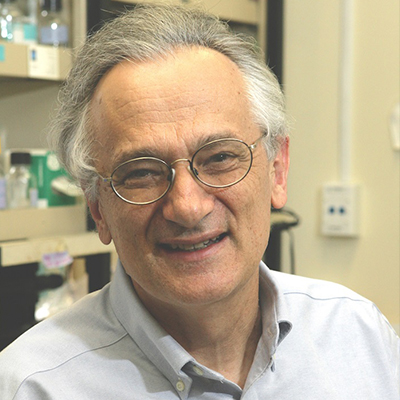Biography
Steven Clarke has been on the faculty of the UCLA Department of Chemistry and Biochemistry since 1978. He is currently a Distinguished Professor of Biochemistry and Director of the UCLA Cellular and Molecular Biology Training Program. He was born in Los Angeles and attended public schools in Altadena and Pasadena, California. He did his undergraduate work at Pomona College in Claremont, majoring in Chemistry and Zoology. During this time, he did undergraduate research at the UCLA Brain Research Institute with Dr. James E. Skinner and Professor Donald Lindsley on neural mechanisms of attention. He was also an NIH fellow in the laboratory of Dr. Peter Mitchell at Glynn Research Laboratories in Bodmin, England studying mitochondrial amino acid transport. He obtained his PhD in Biochemistry and Molecular Biology at Harvard University working as an NSF Fellow with Professor Guido Guidotti on membrane protein-detergent interactions and the identification of the major rat liver mitochondrial polypeptides as enzymes of the urea cycle. He returned to California to do postdoctoral work as a Miller Fellow at the University of California, Berkeley, with Professor Dan Koshland, identifying membrane receptors for bacterial chemotaxis. His research at UCLA has focused on roles of novel protein methyltransferases in aging and biological regulation highlighted by discoveries of the protein L-isoaspartyl repair methyltransferase, the isoprenylcysteine protein methyltransferase, and the protein phosphatase 2A methyltransferase. He has been a visiting scholar at Princeton University (1986-87), the University of Washington (2004-2005), and Vanderbilt University (2015).
Publications
A selected list of publications:
Fu Xudong, Chin Randall M, Vergnes Laurent, Hwang Heejun, Deng Gang, Xing Yanpeng, Pai Melody Y, Li Sichen, Ta Lisa, Fazlollahi Farbod, Chen Chuo, Prins Robert M, Teitell Michael A, Nathanson David A, Lai Albert, Faull Kym F, Jiang Meisheng, Clarke Steven G, Cloughesy Timothy F, Graeber Thomas G, Braas Daniel, Christofk Heather R, Jung Michael E, Reue Karen, Huang Jing
2-Hydroxyglutarate Inhibits ATP Synthase and mTOR Signaling Cell metabolism, 2015; 22(3): 508-15.
Yang Yanzhong, Hadjikyriacou Andrea, Xia Zheng, Gayatri Sitaram, Kim Daehoon, Zurita-Lopez Cecilia, Kelly Ryan, Guo Ailan, Li Wei, Clarke Steven G, Bedford Mark T
PRMT9 is a type II methyltransferase that methylates the splicing factor SAP145 Nature communications, 2015; 6(27): 6428.
Feng You, Maity Ranjan, Whitelegge Julian P, Hadjikyriacou Andrea, Li Ziwei, Zurita-Lopez Cecilia, Al-Hadid Qais, Clark Amander T, Bedford Mark T, Masson Jean-Yves, Clarke Steven G
Mammalian protein arginine methyltransferase 7 (PRMT7) specifically targets RXR sites in lysine- and arginine-rich regions The Journal of biological chemistry, 2013; 288(52): 37010-25.
Nayak Nihar R, Putnam Andrea A, Addepalli Balasubrahmanyam, Lowenson Jonathan D, Chen Tingsu, Jankowsky Eckhard, Perry Sharyn E, Dinkins Randy D, Limbach Patrick A, Clarke Steven G, Downie A Bruce
An Arabidopsis ATP-dependent, DEAD-box RNA helicase loses activity upon IsoAsp formation but is restored by PROTEIN ISOASPARTYL METHYLTRANSFERASE The Plant cell, 2013; 25(7): 2573-86.
Dhar Surbhi, Vemulapalli Vidyasiri, Patananan Alexander N, Huang Grace L, Di Lorenzo Alessandra, Richard Stephane, Comb Michael J, Guo Ailan, Clarke Steven G, Bedford Mark T
Loss of the major Type I arginine methyltransferase PRMT1 causes substrate scavenging by other PRMTs Scientific reports, 2013; 3(1): 1311.
Webb Kristofor J, Zurita-Lopez Cecilia I, Al-Hadid Qais, Laganowsky Arthur, Young Brian D, Lipson Rebecca S, Souda Puneet, Faull Kym F, Whitelegge Julian P, Clarke Steven G
A novel 3-methylhistidine modification of yeast ribosomal protein Rpl3 is dependent upon the YIL110W methyltransferase The Journal of biological chemistry, 2010; 285(48): 37598-606.
Alfaro Joshua F, Gillies Laura A, Sun He G, Dai Shujia, Zang Tianzhu, Klaene Joshua J, Kim Byung Ju, Lowenson Jonathan D, Clarke Steven G, Karger Barry L, Zhou Zhaohui Sunny
Chemo-enzymatic detection of protein isoaspartate using protein isoaspartate methyltransferase and hydrazine trapping Analytical chemistry, 2008; 80(10): 3882-9.
Urzica Eugen I, Casero David, Yamasaki Hiroaki, Hsieh Scott I, Adler Lital N, Karpowicz Steven J, Blaby-Haas Crysten E, Clarke Steven G, Loo Joseph A, Pellegrini Matteo, Merchant Sabeeha S
Systems and trans-system level analysis identifies conserved iron deficiency responses in the plant lineage The Plant cell, 2012; 24(10): 3921-48.
Lissina Elena, Young Brian, Urbanus Malene L, Guan Xue Li, Lowenson Jonathan, Hoon Shawn, Baryshnikova Anastasia, Riezman Isabelle, Michaut Magali, Riezman Howard, Cowen Leah E, Wenk Markus R, Clarke Steven G, Giaever Guri, Nislow Corey
A systems biology approach reveals the role of a novel methyltransferase in response to chemical stress and lipid homeostasis PLoS genetics, 2011; 7(10): e1002332.
Chen Tingsu, Nayak Nihar, Majee Susmita Maitra, Lowenson Jonathan, Schäfermeyer Kim R, Eliopoulos Alyssa C, Lloyd Taylor D, Dinkins Randy, Perry Sharyn E, Forsthoefel Nancy R, Clarke Steven G, Vernon Daniel M, Zhou Zhaohui Sunny, Rejtar Tomas, Downie A Bruce
Substrates of the Arabidopsis thaliana protein isoaspartyl methyltransferase 1 identified using phage display and biopanning The Journal of biological chemistry, 2010; 285(48): 37281-92.





